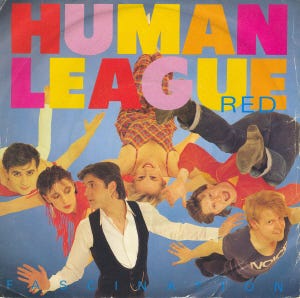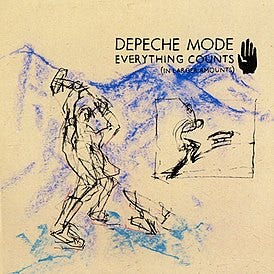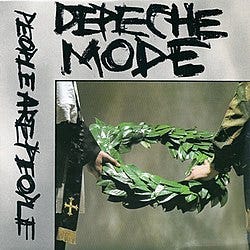Listen here, or read on!
Intro
As the number of new wave artists mushroomed, and the style had a chance to evolve, substyles were carved out of it. The big ones included synthpop, new romantic, post-punk crossover, and ska revival. These aren’t rigid categories—Duran Duran started as new romantic but shifted mainstream later in the ’80s. Let’s explore key differences in the synthpop sounds vs mainstream new wave, using popular bands that (in the late ‘70s to mid ‘80s) had a purer synthpop sound: The Human League and Depeche Mode. We’ll compare two synthpop tracks to two popular early new wave hits by Blondie and The Cars.
General Differences
Synthpop leans into emotional detachment more than mainstream new wave—even its love songs feel cool and remote. Lyrically, it favors themes like technology, alienation, and repetition, not for urgency but for hypnotic effect. Guitars take a back seat to looping synths and drum machines, reinforcing control and artificiality. Vocals often match this mood: flat, affectless, sometimes processed through vocoders, creating distance rather than warmth. While mainstream new wave can be ironic or angsty, synthpop builds its identity around precision, minimalism, and detachment—where emotion is implied by the structure, not shouted through the voice.
The Human League
Love Action vs Shake it Up (The Cars)
The Human League released Love Action in support of their first album with fellow vocalists Sulley and Cathrall. It’s a love song, sort of—but just describing the idea of love, not expressing it to anyone. Oakey immediately undercuts the lyrics by wryly saying “This is Phil talking”. The wording is repetitive. For Shake It Up, Ocasek is more conversational, and the lyrical meaning and tone are unambiguous. He’s strongly selling you on the concept of partying, rather than describing it.
Love Action is definitely more catchy and danceable than the League’s first two albums. There’s still a robotic feel—just a friendlier robot. The instruments (the synths) are constantly looping, with minimal chord changes. Rhythm is emphasized over harmonic development. While the Cars were not afraid to use synths, they were more for sparkly support, and Shake It Up reflects this. It’s anchored by a crisp, rhythmic guitar riff. Unlike Love Action, this and other hooks in the song are compact and structured around chorus payoffs.
Oakey’s dry, monotone vocals enhance the song’s synthetic detachment. The band’s vocals are pixel-perfect, as expected in synthpop. Shake It Up, like Love Action, has Ocasek’s cool vocal delivery which sometimes veers a bit into sarcasm. But he’s trying to be a relaxed, hip mentor on how to party and his slight vocal drawl adds personality. Ocasek adjusts his vocals to the bounce of the beat and they cut cleanly through the mix.
Human League - Love Action (listen on Spotify)
Fascination vs One Way or Another (Blondie)
Fascination was the follow-up to the monster hit Don’t You Want Me, and the League dialed down their sarcasm for this one. This one’s actually optimistic and a bit emotional! Oakey stays true to the League’s brand of minimal, repetitive phrasing. They lean into a tone of fascination but stay true to their minimalistic strengths. One Way or Another is lyrically the reverse of Fascination - Debbie Harry wants to make you uncomfortable through a combo of flirting and staking, but will use her personal flair and strong narrative drive to make that happen.
The melody to Fascination is carefully constructed with bright and danceable synths. Indeed, there are no melodic tension or curveballs. In keeping with this, the verses blends easily into the choruses. One Way or Another is the opposite with its gritty tension, which matches the lyrics beautifully. The changes in melody and verse/chorus contrast reduce danceability—but build an emotional arc.
Fascination has polished vocals which are evenly blended among Oakey and Sulley/Cathrall. You can tell the three vocalists are smiling, but the lack of grit keeps the focus on the danceability while preserving their detached affect. Debbie Harry takes a different route with One Way or Another —switching between sweet and threatening with the disturbing ease of Billy Idol. And unlike the bridge in Rapture, the vocals are raw and front-loaded with emotion, selling the idea that you should worry!
Human League - Fascination (listen on Spotify)


Depeche Mode
Everything Counts vs Let’s Go (The Cars)
Both are radio-friendly new wave hits, but that’s where similarities end.
Like People are People a year later, Everything Counts is strong on social critique. This time, it’s about corporate greed and exploitation (“The grabbing hands grab all they can”). Martin Gore’s lyrics, while earnest, are morally distant. And again, repetition is used to emphasize his point. Let’s Go is the opposite: The Cars throw in some ambivalence (“Let’s Go” - go where)? The language is casual and playful. Unlike People are People, the first/second person interchange suggests intimacy and attitude. That being said, the Cars are a bit emotionally detached in this song.
Everything Counts’ melody is driven by minor keys in the form of a xylophone-like synth. Depeche layered textures and loops with restrained complexity. While the Cars are more guitar-driven, Let’s Go blends in synths greatly, creating a balanced sound while keeping the riffs tight and clean. A typical mainstream track, verse and chorus contrast nicely.
The call-and-response nature of Everything Counts is amplified by the interplay of Gahan’s smoother deep voice and Gore’s sharper, higher voice (an underrated strength of theirs). The delivery is calculated like a good synthpop single. The vocals are strong on message and Depeche is ok with dialing back the charisma. Ocasek is more straightforward with his vocals on Let’s Go. His message resonates using phrasing and attitude, rather than technical skill. His vocals ride the groove instead of driving the emotional core.
Depeche Mode - Everything Counts (listen on Spotify)
People are People vs Call Me (Blondie)
Switching gears to Depeche Mode, let’s see how their early hit People are People stacks up against Blondie’s juggernaut Call Me.
I see parallels between People Are People and synthpop cousin Love Action: Martin Gore goes the political route and is genuine about it. Staying true to early Depeche Mode’s detachment, he avoids direct address and opts for metaphor. In Call Me, while Harry dials back the lyrical complexity, its clear she’s passionate that you must call her right away. The lyrics are emotional, not abstract.
In People Are People, the synth riffs and rhythms are industrial and metallic. The repetition adds to its machine-like feel. Before Harry even drops a note, the guitar-synth hybrid riff that perpetuates ensures the urgent nature of the song. Like the other mainstream new wave songs I mentioned, there is a strong buildup to the chorus, rather than a seamless blend.
While Gahan is assertive on People Are People, he is also emotionally contained and cool, so the song doesn’t deviate far from classic synthpop. The harmonies are tightly produced and synthetic. Again, emotion is driven not by a vocal hook, but rather from repetition. In contrast, Call Me features bold, sultry, and unfiltered vocals from Harry.
Depeche Mode - People are People (listen on Spotify)


In Conclusion
Synthpop and mainstream new wave often shared the same stages, charts, and fans—but their emotional cores were worlds apart. Where mainstream new wave thrives on personality, immediacy, and guitar-pop charm, synthpop builds its atmosphere with detachment, loops, and machine precision. By spotlighting The Human League and Depeche Mode against Blondie and The Cars, we can see how these sonic worlds coexisted—sometimes overlapping, often diverging. Both substyles shaped the genre’s legacy, but their differing choices in lyrics, melodies, and vocals reflect two very different ways of processing the modern world—one through feeling, the other through circuitry.



